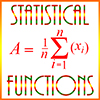Statistical Functions – Definitions of Terms
Arithmetic Mean: The average of a list of values, in which there could be repetitions. For example, if L = 3, 7, 3, 4, 3 is a list of values, then the arithmetic mean of L is (3 + 7 + 3 +4 + 3)/5 = 20/5 = 4.
Average: If L = 3, 7, 3, 4, 3 is a list of values, then the average of L is the sum of its values divided by the number of values in the list.
Frequency Distribution: A display or mathematical function which shows how many times, or the frequency with which, a variable has each of the values it takes on. For example, suppose Jane sells this number of insurance policies each week in a 10 week period:
1, 3, 1, 4, 5, 3, 2, 1, 1, 2
Then the frequency distribution of these numbers is shown in this table:
| Number of Policies Sold | Frequency |
| 1 | 4 |
| 2 | 2 |
| 3 | 2 |
| 4 | 1 |
| 5 | 1 |
Mean: The computed average of a list of numbers. For example, the mean of a list of 3 numbers is calculated by adding the 3 numbers together and then dividing by 3.
Median: The number whose value is in the middle of the values of a list of numbers. Example: In the list, 8, 15, 6, 9, 14, the median is 9, since its value is less than 14 and 15, and greater than 6 and 8.
Mode: The value in a list of values that occurs the most frequently. Thus, if we have a list, 3, 8, 8, 4, 7, then the mode is 8.
Range of a Set of Values: The difference between the lowest and the highest values in a set of values. Example: The set of values -4, -1, 8 has a range of 12, since 8 – (-4) = 8 + 4 = 12.
Standard Deviation: A statistical function which is used as a measure of the dispersion of a set of values, the larger (or smaller) the standard deviation, the greater (or the less) the dispersion. It is calculated as follows:
- Find the mean of the set of values.
- Calculate the difference of each number and the mean.
- Square each of these differences.
- Take the average of all the squared differences calculated in step 3.
- Take the square root of the average calculated in step 4.
Example: Suppose the values are 1, 2, 4, 5. Then the mean is 3, and the numbers of steps 2 and 3 are shown in the following table:
| x | x – mean | (x – mean)2 |
| 1 | -2 | 4 |
| 2 | -1 | 1 |
| 4 | 1 | 1 |
| 5 | 2 | 4 |
The average of 4, 1, 1, and 4 is 2.5. The square root of this is approximately 1.58. This is the standard deviation for this sample set to two decimal places.
Statistical Function: A number calculated from a set of values. The particular function is intended to identify something about the set as a whole. Commonly used functions include the mean, median, mode, range, variance, and standard deviation.
Variance: A statistical function which provides a measure of the distribution of a set of data values. It’s calculated by taking the square of the difference of each value and the mean, and then taking the average of these values. The square root of the variance is the standard deviation.
